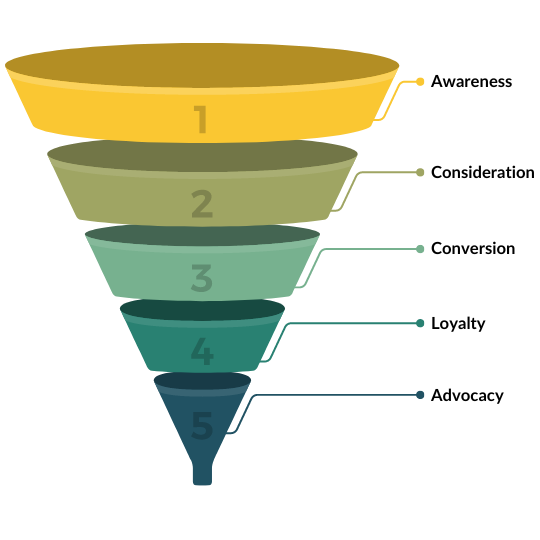
Getting your content in front of your target audience is important, but it is just one piece of the puzzle. Getting your content in front of those people at the right time is the more important piece of the puzzle.
Because of this, it is vital to align your content efforts to each stage of the marketing funnel. And that means truly understanding the purpose of each marketing channel within your overall strategy. It also means understanding which types of content to produce for which stage of the funnel.
The difficulty for e-commerce businesses is determining which content pieces best serve your target audience at which stage of the buyer journey.

Identify your target audience
The first step to getting your content in front of the right people is to define who they are. You will need to understand their demographics, psychographics, and pain points.
More specific examples of the information you might want to tease out of your audience include:
- Demographics: Age, gender, location, income, etc.
- Psychographics: Interests, behaviours, values, aspirations, etc.
- Pain points: Identifying problems your product/service can solve, and how.
When you build out your target audience, you will need to get specific on how each customer group differs, but also where the overlaps in these groups lie.
Segment your target audience
To help you get the most out of your target audience, it is best to segment it. This can be done based on shared characteristics or buying behaviours.
This is important because you can start to align your content with each customer segment. Different segments will require different pieces of information. If you know who you’re speaking to more specifically when building your content, you will find that it flows more easily.
Getting specific on your target audience and segmenting it will lay the foundation for creating content that resonates with each specific group.
What’s also great is that you can even build your business strategy and potential product line expansions around these segments, as you might find specific products appeal to specific segments.
Leverage data & analytics for your research
When it comes to defining and segmenting your target audience, and building your content plan, data is your friend.
You can use data from your website analytics platform, social media insights, and existing customer data to gain a deeper understanding of your audience’s behaviours and preferences. Make sure you also conduct market research and a competitive analysis to identify trends and gaps in your industry.
The data can help you understand which questions are being asked, and where your competitors’ content lacks in substance. That means you’ll be ahead of the game in terms of identifying gaps in competitor content which you can fill.
Craft compelling content
We will talk more in-depth about building a strong content plan through the use of a content gap analysis in our next blog. However, this is just one piece of the puzzle.
Once you know broadly what type of content needs creating, you’ll need to consider how to craft the content using your customer’s language. This will help your target audience resonate with your content more easily. Make notes of the language they are using in customer service calls and reviews, and incorporate it into your messaging.
Don’t forget, most of the content you’re looking to create will already exist in one form or another on the web. So how can you craft it in a way that will drive customers to buy from you? You’ll need to bring your brand ethos and personality into it to become more unique.
And each customer will be in a different part of the buyer journey, so don’t just consider creating content to push them to buy. Create content to create brand awareness, interest, loyalty and advocacy.
Devise a targeted content marketing strategy to reach your target audience
Simply creating your content is not enough to ensure the right eyes are on it. You will also need to consider how you are marketing the content. You have a few options depending on the type of content you are creating:
A new product launch: consider using paid media channels (PPC/Paid Social) to push the launch and get customers interested as this is closer to the bottom of the marketing funnel.
Blog content: ensure you are optimising it for SEO to cover all of the basics and pushing it out through organic social media as this content sits closer to the top of the marketing funnel.
Broader hero content pieces such as research papers, interactive content, etc: ensure you are using digital PR to speak to publications and push out the message to a broader audience pool as this content also sits closer to the top of the marketing funnel.
GET IN TOUCH WITH OUR EXPERT TEAM TODAY TO FIND OUT HOW WE CAN HELP.
Cross-promote your content
Another great way to amplify your content is to consider cross-promotion.
Cross-promotion can be done through repurposing your content across different channels such as organic social media, email newsletters, etc. Create smaller, bite-sized chunks of content based on your larger blog content piece, for example, and you’ll likely have 1-2 weeks’ worth of organic social media posts and emails to push out.
It’s also a great idea to use your content to encourage new, user-generated content such as reviews/tersimonials/etc. You can share this type of content on your social media platforms as social proof to bring in additional customers.
Continually learn and adapt your content to fit
Finally, your website content can evolve over time. Don’t consider it as a one-and-done job but keep thinking about ways to tweak and improve it. As you learn more about your customer behaviours you can adapt old pieces of content to suit their needs.
As you learn more about product materials, product lines, and buyer behaviours, you can also incorporate new information where it’s required. Don’t just adapt your product content, but make sure you are continuing to tweak your blogs, category pages, and even your home page messaging.
In summary…
To get your content in front of the right people, you need to identify your target audience and define it clearly.
Your content won’t perform simply because you’ve published it. You will need to push it out through different marketing mediums to ensure you are able to reach a broader target audience than the existing one.
You also need to consider continuously adapting and improving your content once it has been published. Your audience behaviours and learnings will evolve over time, so your content needs to as well. Don’t leave your content to become stale and unused, make it work for you over time.
Finally, don’t forget that each stage of the buyer journey requires a different type of content. This will help push potential and previous customers down the conversion funnel and into a purchase, brand loyalty, and ultimately brand advocacy.
Want to know more about getting your content in front of the right target audience? Get in touch with us or book a free strategy call today!
LET’S CONNECT
If you would like to keep up to date with our latest news, resources, and more then subscribe to our mailing list here




